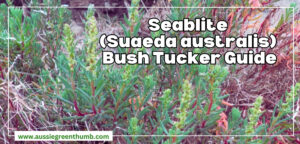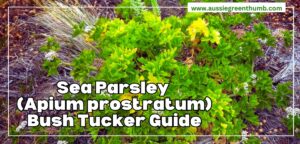With flowers reminiscent of the African Kniphofia (red hot poker), Grevillea ‘Superb’ is one of the most jaw-droppingly dramatic grevilleas you can grow at home, and even better it’s an Australian native.
To grow your own gorgeous grevillea hedge, or even prune these short grevilleas into a dwarf tree form, follow our guide for everything you could possibly need to know about these brilliantly bonkers hedging shrubs.
More...
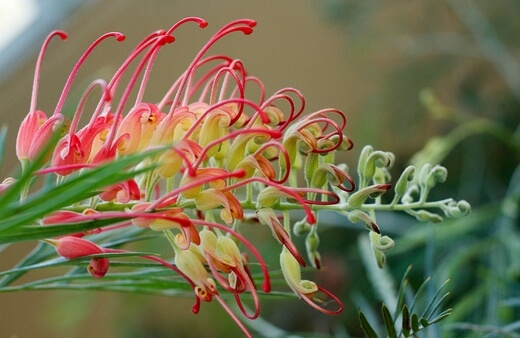
Family: | Proteaceae |
|---|---|
Genus: | Grevillea |
Species: | Hybrid of G. banksii and G. bipinnatifida |
Cultivar: | ‘Superb’ |
Common Names: | Grevillea ‘Superb’ |
Location: | Outdoor |
Type: | Shrubs |
Growth: | 1.5-2m (height and width) |
Sun requirements: | Full sun or light shade |
Foliage Colour: | Green, Silver-green |
Flower Colour: | Deep pink |
Flowering: | All year |
Fruit: | Not edible |
Maintenance level: | Low |
Poisonous for pets: | Toxic to cats and dogs |
What is Grevillea ‘Superb’?
Grevillea ‘Superb’ is a hybrid between Grevillea banksii and Grevillea bipinnatifida, so technically should be called Grevillea banksii x bipinnatifida ‘Superb’, but that’s probably too much of a mouthful, so let’s just stick to Grevillea ‘Superb’!
The textural foliage gives year-round interest, and the fast-forming flowers open on a daily basis almost all year round, so it’s easy to prune, and quick to recover, making it an ideal hedging plant.
Grevillea ‘Superb’ Natural Habitat
Grevillea ‘Superb’ isn’t technically native to anywhere as it’s a man-made cultivar, bred from banksii and bipinnatifida, using the best qualities of both to produce a long-flowering, evergreen shrub that’s happy to be pruned hard, lightly, and even tightly clipped for an almost formal hedge.
Both of its parent species are native to Australia, and predominantly found growing wild around Queensland, so need a warm location in full sun to perform at their best, but work pretty well in light shade too.
How to Grow Grevillea ‘Superb’
Grevillea ‘Superb’ grows best with reasonable, but not fast, drainage. The more moisture you give it before it gets too damp (I admit, it’s a fine balance) the better it will perform, and the longer it will flower.
Follow our planting guide below to establish your hedging plants and shrubs faster, and with less maintenance after planting.
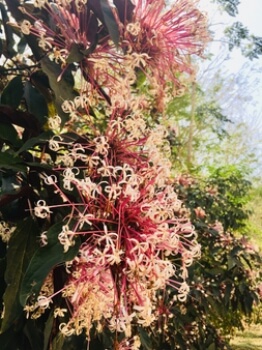
Best Conditions to Planting Grevillea ‘Superb’
To get started, check if the roots around the pot of your young grevillea are happy and healthy. If they are wound tightly around in circles inside the pot, tease them out gently. Don’t worry if you break a few roots, that will stimulate new growth, and only serve as beneficial.
Dig a planting hole at least twice the size of the root ball, and try to stick to a square hole. Square holes are not just easier to dig, but they’re better for root development too, as any winding roots will eventually hit a corner, and have to spread in one direction or the other, making for a better grip in the soil.
Preparing the Soil and Drainage
Before you get started, once your hole is dug, you’ll need to ensure the soil is right for grevillea planting. pH isn’t particularly important, but slightly acidic, rather than slightly alkaline is better to help with nutrient and mineral absorption.
If you’ve got a soil testing kit, check that phosphorous levels aren’t too high. If they are, just add plenty of new soil or compost into the hole to even it out (phosphorus limits the flowering season of grevillea, regardless of the species).
Any nitrogen or potassium focussed compost, soil, or even sand, will help to create a good nutrient balance to get started.
Light and Temperature Requirements
Light is more important than temperature, as Grevillea ‘Superb’ is pretty tough, and hardy below freezing, so won’t mind a cooler, or slightly wind-exposed plot, provided it gets at least 6 hours of direct light per day.


Get Your Free Guide:
Master Growing Australian Natives eBook
A Must Have Complete Guide for Every Australian Garden
Get Your Free Guide:
Master Growing Australian Natives eBook
A Must Have Complete Guide for Every Australian Garden
8 hours is better if you can give it, but don’t focus too heavily on this, provided it's got a bright spot and isn’t growing under a canopy or with loads of competition.
Watering Schedule
When you initially plant Grevillea ‘Superb’, get it off to an easy start in life by watering really thoroughly so the water puddles on the soil surface. This creates good connections between the soil and the roots and helps to get rid of air pockets underground where funguses can multiply.
For the first two months, water weekly to help young roots establish themselves in a new location, and once new growth is clearly growing, stop watering entirely. Once it’s growing by its own devices, there’s no need to water Grevillea ‘Superb’ other than what the weather throws at it.
Propagating Grevillea ‘Superb’
For 99% of plants we write about here at Aussie Green Thumb, we focus on seeds first, because it’s almost always the cheaper, and easier way to propagate, but growing any grevillea from seed is a slow and patient process, and Grevillea ‘Superb’ is even slower!
So, to get you started on propagating your own grevillea for free, why not try cuttings:

Grevillea ‘Superb’ Propagation from Cuttings
Propagating from cuttings means, very simply, using a cut part of the plant to create new plants. These new plants will be exact replicas of the parent and don’t cost a penny. In fact, in most parts of Australia, you can grow grevillea cuttings straight in the ground without any need for pots, propagators, or greenhouses!
Grevillea ‘Superb’ is great for cuttings if you’re new to it. Simply choose a non-flowering stem (that means any stem which hasn’t shown signs of bud formation, or had a flower on previously.
- Start by cutting the stem down to a node, taking 15-20cm of growth per cutting.
- Mix loads of sand, grit, and compost into the garden soil, and dib a few stem-width holes in the ground using a pencil or a bamboo cane.
- Dip the cut end of your Grevillea ‘Superb’ in rooting hormone, and gently insert it into the planting hole.
- Water it really well, and try to keep it shaded from the full sun.
- Water whenever the soil looks slightly dry.
- When new growth starts, just begin to treat it like a mature plant, with rare watering, and move it to a final position when it’s got 1 ft or more of new growth, being careful not to damage its roots when you dig it up.
Note: You can take Grevillea ‘Superb’ cuttings at any time of year as they are actively growing all year round in almost all parts of the country.
Propagating Grevillea ‘Superb’ from Seeds
Grevillea ‘Superb’ seeds, like all grevilleas take a few years to germinate in nature. The seed shells are incredibly tough and require several seasons of heating and cooling to trigger germination.
You can trick them into germinating faster by putting them in an air-tight bag in the fridge for one week, then somewhere warm for one week, and repeating the process four times. After two months, you can expose them to light, soil, and moisture, and they should germinate if you’re lucky.
But, as I said, it’s much simpler to take cuttings!
Grevillea ‘Superb’ Care Guide
Grevillea ‘Superb’ is one of the easiest grevilleas to care for once it’s established. It needs no mulch (but can benefit from it), and no fertiliser (but can benefit from it, no pruning (but can benefit from it)… do you see where I’m going?
Essentially, you don’t need to do anything to keep a Grevillea ‘Superb’ happy, but the more you care for it, the more it will give back in flower and drama.
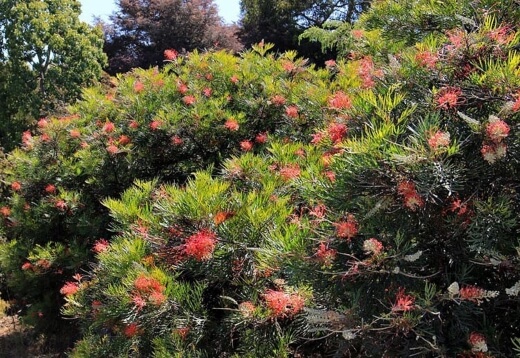
Source: Gardenia
Mulching
Once every two, or even three years, mulch Grevillea ‘Superb’ heavily with organic mulch, such as wood chip or leaf mould. Nitrogen is key, so avoid mixed composts with phosphorous or heavy potassium content.
Best Fertiliser to Use
As a native plant geek, I can confirm that there is a big difference between native shrub fertilisers and native herbaceous fertilisers. Pick a good quality, nitrogen-heavy, slow-release native shrub fertiliser and apply in limitation once a year in spring.
Pruning Needs
Grevillea ‘Superb’ is one of the easiest shrubs to prune. With an ultimate height of just 2m there really isn’t any need to prune it, as it will continue to flower year after year when it reaches its full height.
However, pruning encourages new lateral growth, so once it reaches 1.5m, aim to keep it to roughly that height with a harsh annual prune in spring. Grevillea ‘Superb’ will respond to harsh spring pruning by flowering much more vigorously and for longer in the year.
Common Grevillea ‘Superb’ Pests and Diseases
Grevillea ‘Superb’ has no significantly damaging pests, but there are a few scale insects that can be problematic. In terms of diseases, like any wild native plant grown in cultivation they will suffer from fungal infections if they are too damp, so amend any moisture-retentive soil before planting.
Leaf borers
Leaf borers are the most frustrating pest on Grevillea ‘Superb’, thanks to their ability to cause leaf drop, and spotty damage to foliage. If you notice ring-shaped patterns on foliage or yellow spots on leaves, it’s usually down to leaf borers.
They can create a way in for fungal problems and are quite hard to get rid of using traditional insecticides as they are protected from the outer surface of the leaf.
However, using neem oil will help to deter them, and you’ll often notice the problem slowing down or disappearing completely after a light application of neem oil.
Scale
Scale insects have a hard outer shell that protects them from a lot of chemical pesticides so, by far, the most effective way to get rid of them is to use a natural deterrent.
Spraying mint tea, garlic, or neem oil solutions onto the plant makes it distasteful, and ingesting a large amount of neem oil will kill them. Direct application will dehydrate their eggs too.
Fungal problems
There are dozens of fungal problems that can affect Grevillea ‘Superb’, and all tend to look fairly similar. Brown, black or squishy stems are the most common sign, but bud rot and brown lesions on foliage are also easy to spot.
Remove any fungal damage on the plant by cutting back to a few inches below the affected area and burning the damaged material.
If you notice signs of root rot, such as dry top growth, paired with damp soil, cut out the damaged top sections, and apply a soil fungicide (usually copper-based) to dry out and kill the root fungus.
Black Sooty Mould
Black Sooty Mould will damage new shoots after pruning, and if you regularly suffer from the problem, the best solution is often to stop pruning as the resulting growth will be slower, stronger and more resistant.
Remove any dropped leaves, particularly if they show signs of black mould.
Grevillea ‘Superb’ Frequently Asked Questions
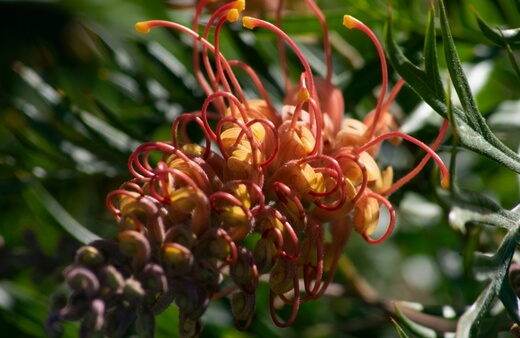
How long do Grevilleas live?
Grevillea ‘Superb’ tends to live for about 15 years if well kept. When blooms start to slow down, consider taking cuttings and storing them in a low-use part of the garden to replace plants as they start to fade.
That way you’ll be able to instantly replace sections of hedging as soon as they fade.
Does Grevillea ‘Superb’ have invasive roots?
Grevillea ‘Superb’ has not got invasive roots. The roots of all grevilleas are particularly shallow and will not damage concrete, metal, or even timber structures in their path.
What is a good companion plant for Grevillea ‘Superb’?
Grevillea ‘Superb’ is a fairly low-maintenance hedge, so to tie in with the same style of planting, choose grasses or perennial bulbs that will flower year after year with little intervention.
That way you’ll have floral interest all year round at every height along your borders.
Are Grevillea ‘Superb’ flowers edible?
The flowers of Grevillea ‘Superb’ are in fact edible and can be sucked for their sweet nectar, or even ground up and dried. The pollen is the source of most of the flavour, so use freshly blooming flowers for the most flavour.
Where does Grevillea ‘Superb’ grow best?
Grevilleas grow best in full sun and on well-drained soil. In shaded conditions, Grevillea ‘Superb’ will grow tall and leggy with fewer flowers. Similarly, in shaded conditions, drainage is incredibly important as the soil will retain too much moisture and can cause root rot.
What is the best soil for Grevillea ‘Superb’?
The best soil for Grevillea ‘Superb’ is well-drained, neutral soil, or slightly acidic soil. Any soil with a pH higher than 7 can kill this grevillea hybrid or stunt its growth, and damp soil will dilute acids and prevent the uptake of nutrients.
What kills Grevillea ‘Superb’?
Grevillea ‘Superb’ is a tough shrub that really is hard to kill. However, using fresh chook manure or even pelleted hen manure can shock the roots and cause significant browning of the leaves.
If you notice brown leaves or curled crisping photos, you may have overfed your plant. Simply soak the soil around the plant to flush out any excess nutrients, and scrape away any mulch or fertiliser.
Can I use Seasol on Grevillea ‘Superb’?
Seasol is brilliant for Grevillea ‘Superb’, as a general-purpose fertiliser that when used properly, will be highly beneficial to the foliage and flowers of these stunning plants.
The best time to use Seasol on Grevillea ‘Superb’ is during dry spells when the soil needs extra moisture, or for the first few months after planting to help establish the roots.
How do you make Grevillea ‘Superb’ bushy?
Making Grevillea ‘Superb’ bushy is the same as working with any other grevillea, and is all about pruning. Prune Grevillea ‘Superb’ once a year at the end of spring when the final flush of winter flowers has come to an end.
This will encourage a new flush of flowers, which can carry on right through summer and autumn in most climates.
Does Grevillea ‘Superb’ like cow manure?
Any fresh manure is bad for Grevillea ‘Superb’, no matter what time of year, or how mature your plant is. The high concentration of acids will unbalance the soil and damage the root system, potentially burning the stem if it comes into contact. Well-rotted manure is safe to use on Grevillea ‘Superb’.
If the shorter varieties like Grevillea ‘Superb’ aren’t to your taste, why not check out our guide to growing Grevillea ‘Robyn Gordon‘, Grevillea ‘Peaches and Cream’, or the sumptuous Grevillea ‘Honey Gem’?
Wrapping Up Our Grevillea ‘Superb’ Growing and Care Guide
Grevillea ‘Superb’ is a shockingly beautiful shrub that’s as easy to grow as any other hedging plant you could consider, and with the added benefit of being native, Grevillea ‘Superb’ will help to bring wildlife into the garden as often as possible.
Published on December 17, 2022 by Nathan Schwartz
Last Updated on February 22, 2024


